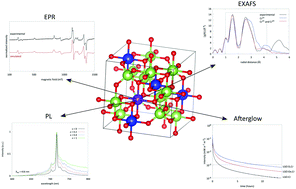Probing the local structure of the near-infrared emitting persistent phosphor LiGa5O8:Cr3+†
Abstract
Near-infrared emitting persistent phosphors have promising applications in the field of in vivo medical imaging. In this paper, we prepared the persistent phosphor LiGa5O8:Cr3+ (LGO:Cr) which exhibits emission in the tissue transparency window and shows afterglow for multiple hours after excitation. Addition of Si or Ge improves the persistent luminescence. X-ray diffraction and electron microscopy, coupled with elemental analysis, revealed that there is a maximum amount of Si or Ge that can be incorporated in the host. Via X-ray absorption spectroscopy and electron paramagnetic resonance experiments, we studied the local environment of chromium in the LGO spinel host. The presence of both Cr3+ and Cr4+ on octahedral sites in LGO was confirmed. Electron paramagnetic resonance showed that Cr3+ resides in a rhombically distorted octahedral lattice site and that the Cr3+ local environment is sensitive to variation in point defects in the surrounding.



 Please wait while we load your content...
Please wait while we load your content...